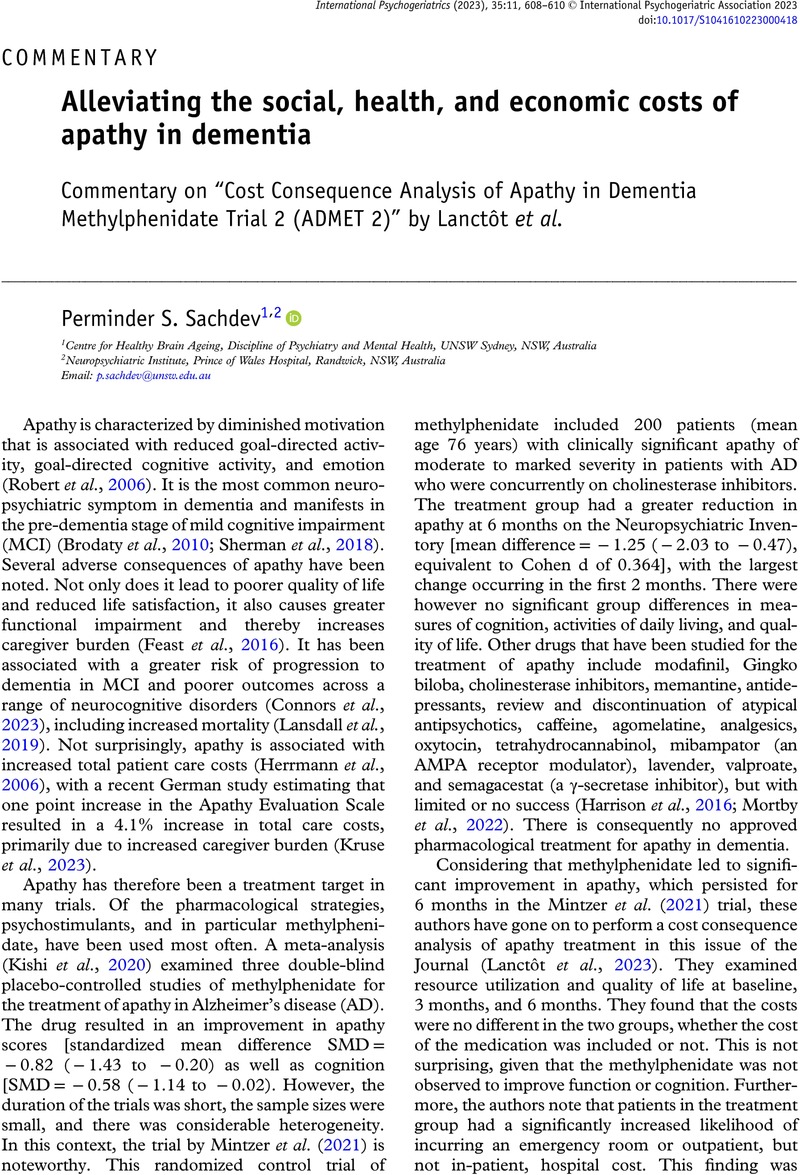No CrossRef data available.
Article contents
Alleviating the social, health, and economic costs of apathy in dementia
Commentary on “Cost Consequence Analysis of Apathy in Dementia Methylphenidate Trial 2 (ADMET 2)” by Lanctôt et al.
Published online by Cambridge University Press: 27 April 2023
Abstract
An abstract is not available for this content so a preview has been provided. Please use the Get access link above for information on how to access this content.

- Type
- Commentary
- Information
- International Psychogeriatrics , Volume 35 , Special Issue 11: Issue Theme: Neuropsychiatric Symptoms of Mild and Major Neurocognitive Disorders , November 2023 , pp. 608 - 610
- Copyright
- © International Psychogeriatric Association 2023
References
Brodaty, H., Altendorf, A., Withall, A. and Sachdev, P. (2010). Do people become more apathetic as they grow older? A longitudinal study in healthy individuals. International Psychogeriatrics, 22, 426–436. https://doi.org/10.1017/S1041610209991335.CrossRefGoogle Scholar
Connors, M. H., Teixeira-Pinto, A., Ames, D., Woodward, M. and Brodaty, H. (2023). Apathy and depression in mild cognitive impairment: distinct longitudinal trajectories and clinical outcomes. International Psychogeriatrics., 30, 1–10. https://doi.org/10.1017/S1041610222001089.CrossRefGoogle Scholar
Cummings, J. et al. (2015). Apathy in neurodegenerative diseases: recommendations on the design of clinical trials. Journal of Geriatric Psychiatry Neurology, 28, 159–173. https://doi.org/10.1177/0891988715573534.CrossRefGoogle ScholarPubMed
Dykstra Goris, E., Ansel, K. N. and Schutte, D. L. (2016). Quantitative systematic review of the effects of non-pharmacological interventions on reducing apathy in persons with dementia. Journal of Advance Nursing, 72, 2612–2628. https://doi.org/10.1111/jan.13026.CrossRefGoogle Scholar
Feast, A., Moniz-Cook, E., Stoner, C., Charlesworth, G. and Orrell, M. (2016). A systematic review of the relationship between behavioral and psychological symptoms (BPSD) and caregiver well-being. International Psychogeriatrics, 28, 1761–1774. https://doi.org/10.1017/S1041610216000922.CrossRefGoogle ScholarPubMed
Harrison, F., Aerts, L. and Brodaty, H. (2016). Apathy in dementia: systematic review of recent evidence on pharmacological treatments. Current Psychiatry Reports, 18, 103. https://doi.org/10.1007/s11920-016-0737-7.CrossRefGoogle ScholarPubMed
Herrmann, N. and Lanctôt, K. L. (2007). Pharmacotherapy of apathy in dementia: a systematic review of the evidence. Journal of Neuropsychiatry and Clinical Neurosciences., 19, 247–254. https://doi.org/10.1176/jnp.2007.19.3.247.Google Scholar
Herrmann, N. et al. (2006). The contribution of neuropsychiatric symptoms to the cost of dementia care. International Journal of Geriatric Psychiatry., 21, 972–976. https://doi.org/10.1002/gps.1594.CrossRefGoogle Scholar
Kishi, T., Sakuma, K. and Iwata, N. (2020). Efficacy and safety of psychostimulants for Alzheimer’s disease: a systematic review and meta-analysis. Pharmacopsychiatry, 53, 109–114. https://doi.org/10.1055/a-1076-8228.Google ScholarPubMed
Kruse, C. et al. (2023). Apathy in patients with Alzheimer’s disease is a cost-driving factor. Alzheimer’s & Dementia. https://doi.org/10.1002/alz.12915.CrossRefGoogle ScholarPubMed
Lanctôt, K. L. et al. (2023). Cost consequence analysis of Apathy in Dementia Methylphenidate Trial 2 (ADMET 2). International Psychogeriatrics, 1–9. https://doi.org/10.1017/S1041610223000327,CrossRefGoogle ScholarPubMed
Lansdall, C. J. et al. (2019). Prognostic importance of apathy in syndromes associated with frontotemporal lobar degeneration. Neurology, 92, e1547–e1557. https://doi.org/10.1212/WNL.0000000000007249.CrossRefGoogle ScholarPubMed
Mintzer, J. et al. (2021). Effect of methylphenidate on apathy in patients with Alzheimer disease: the ADMET 2 randomized clinical trial. JAMA Neurology, 78, 1324–1332. https://doi.org/10.1001/jamaneurol.2021.3356.CrossRefGoogle ScholarPubMed
Mortby, M. E. et al. (2022). Apathy as a treatment target in Alzheimer’s disease: implications for clinical trials. American Journal of Geriatric Psychiatry., 30, 119–147. https://doi.org/10.1016/j.jagp.2021.06.016.CrossRefGoogle ScholarPubMed
Nguyen, J. P. et al. (2018). Efficacy of transcranial direct current stimulation combined with cognitive training in the treatment of apathy in patients with Alzheimer’s Disease: study protocol for a randomized trial. Reviews of Recent Clinical Trials, 13, 319–327. https://doi.org/10.2174/1574887113666180416153316.CrossRefGoogle ScholarPubMed
Padala, P. R. et al. (2018). Repetitive transcranial magnetic stimulation for apathy in mild cognitive impairment: a double-blind, randomized, sham-controlled, cross-over pilot study. Psychiatry Research, 261, 312–318. https://doi.org/10.1016/j.psychres.2017.12.063.CrossRefGoogle ScholarPubMed
Padala, P. R. et al. (2020). Neuromodulation for apathy in Alzheimer’s disease: a double-blind, randomized, sham-controlled pilot study. Journal of Alzheimer’s Disease, 77, 1483–1493. https://doi.org/10.3233/JAD-200640.CrossRefGoogle ScholarPubMed
Robert, P. H. et al. (2006). Neuropsychological performance in mild cognitive impairment with and without apathy. Dementia and Geriatric Cognitive Disorders, 21, 192–197. https://doi.org/10.1159/000090766.CrossRefGoogle ScholarPubMed
Sherman, C., Liu, C. S., Herrmann, N. and Lanctôt, K. L. (2018). Prevalence, neurobiology, and treatments for apathy in prodromal dementia. International Psychogeriatrics., 30, 177–184. https://doi.org/10.1017/S1041610217000527.CrossRefGoogle ScholarPubMed


